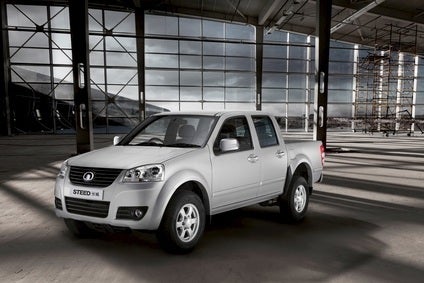
In a decade’s time, will Great Wall have become a rising force across European markets in the way that Hyundai and Kia are now? The newly revised Steed pick-up certainly shows there is potential.
Nobody who saw me in the Steed during my week with it had heard of Great Wall. Most thought the brand’s name is strange and cheesy. In time, I would expect Great Wall Motor to become GWM, worldwide. This pick-up is called the Wingle 6 in China, which sounds comedic in Britain, so the importer, IM Group, wisely changed it. Great Wall is a tiny player in the UK, its sales so minor that the SMMT counts it in its ‘other’ total each month. Even Lotus (230 registrations YtD) Perodua (29), Mia (5), Saab (3) and Proton are listed.
I asked IM how Great Wall has been doing of late and here is its answer: “Since the latest generation Steed became available (September 2014) there have been 270 units sold. In 2013, Great Wall sold a total of 700 units”. Not bad for a brand that people and clearly, the SMMT, haven’t heard of and which is just two years young in this country.
The 50-strong dealership and servicing network is being expanded and I’ve noticed that my local Honda outlet is also now a Great Wall franchisee: this in the small south-western city of Bath. There aren’t any showrooms in central London for the obvious reason of cost but perhaps in time this might change too.
This pick-up truck is what you might call robust and honest. It’s spectacularly good value for money even though the PRC is no longer a particularly inexpensive place to build vehicles. Prices for the recently arrived 2015 model year Steed – it’s had a minor facelift too – start at GBP14,998 and rise to GBP16,998, which is a GBP1,000 increase over the 2014MY trucks. Those numbers mean this is the cheapest double-cab 4×4 pick-up on sale in Britain.
Graeme drove a Steed a couple of years back and found much to like about it, but this 2015MY one is markedly better. There are lots of subtle changes – things such as more contemporary looking upholstery, instruments, standard tyre-pressure monitors, clearer instrumentation, a bang up to date infotainment system and better HVAC controls.

US Tariffs are shifting - will you react or anticipate?
Don’t let policy changes catch you off guard. Stay proactive with real-time data and expert analysis.
By GlobalDataThere is nothing inside that feels or looks way behind the times, even though the basic model has been around since its debut at the 2006 Guangzhou motor show. First there was only a double cab body, but the single cab was added for the Chinese market in 2007. The 2.0-litre diesel obviously meets the EC’s emisions standards, and isn’t too noisy or rough either. The engine is manufactured at Great Wall’s own Baoding powertrain plant. A 2.8-litre diesel which was once available in the PRC has never been offered here.
The Steed might only have been available in the UK since March 2012 but it has a much longer history in other parts of Europe. The first exports to Italy and Romania commenced in 2007, though the Wingle had also gone on sale in Russia during 2006. The model’s right-hand drive debut was in the Australian market, in 2009.
In January 2011, Great Wall revealed plans for small scale assembly of this pick-up at a facility in the Philippines, while SKD assembly at Great Wall’s Bulgarian plant commenced in late 2012. Now that the model’s mid-life facelift is behind it, the Wingle/Steed has probably another 3-5 years of production remaining and it would seem logical to expect the successor will use the same basic platform as the current vehicle. That’s a body-on-frame construction with rear- and/or four-wheel drive. Like other pick-ups of this size, that also means leaf springs at the rear but the Steed has disc rear brakes, setting it apart from some supposedly more advanced Japanese brand rivals.
Push this pick-up towards its limits and you won’t find much in the way of nasty surprises. There’s a lot of lean if you flick it into a sharp bend, but then why would you? Traction is very good, even on wet roads and with no load in the back, which was not something I had expected. Similarly, braking performance was also no worse than class rivals such as the Hilux, Navara, Ranger, D-Max and L200. In other words, don’t expect any of these small trucks to stop on a six-pence but they’re a long way ahead of previous generation pick-ups.
As an every day car, the Steed makes a convincing case for itself. Sure, it might be a bit long for some people but then it had one of the best reversing radar systems I’ve used: you get countdown of distance via a dashboard display. It’s also not too wide, and the test vehicle had handy side-steps and a fixed roof over the load bay. The gearchange was a bit on the slow side but you don’t drive a vehicle like this as a sports car. There is also a lot of room for all five occupants and the importer has specified a wealth of standard equipment. So all in all, for the money, the Steed is hard to beat.



